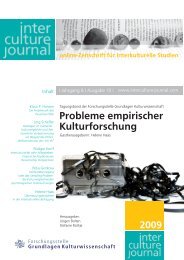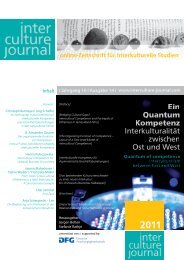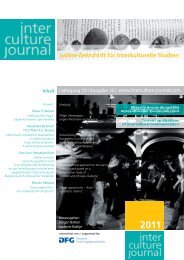Grundlagen Kulturwissenschaft - Interculture Journal
Grundlagen Kulturwissenschaft - Interculture Journal
Grundlagen Kulturwissenschaft - Interculture Journal
Erfolgreiche ePaper selbst erstellen
Machen Sie aus Ihren PDF Publikationen ein blätterbares Flipbook mit unserer einzigartigen Google optimierten e-Paper Software.
The Definition of<br />
Culture:<br />
An application-oriented<br />
overhaul<br />
Prof. Dr. Stefanie Rathje<br />
Professur für Unternehmensführung<br />
und Kommunikation,<br />
Hochschule für Technik und Wirtschaft<br />
Berlin<br />
Rathje: The Definition of Culture: An application-oriented overhaul<br />
Abstract<br />
This article revisits traditional definitions of culture to establish<br />
a sound criticism of existing coherence-based approaches.<br />
By expanding the one-dimensional concept of culture to a<br />
four-field-matrix, a likewise contemporary and practical concept<br />
of culture is formulated which is also likely to supply reasonable<br />
answers to disputed questions regarding the formation<br />
of cohesion in society. It is finally argued that the prevalent<br />
diagnosis of multicollectivity should be expanded to a<br />
desideratum of radical multicollectivity, the goal of providing<br />
increasing individual access to ever more collectives, leading<br />
to an increase in both social stability and developmental dynamics.<br />
1. The paradigm of coherence in the traditional concept<br />
of culture: that which unifies<br />
Our everyday understanding of culture is characterized by an<br />
expectation of uniformity.<br />
The most common understanding of culture is one that imagines<br />
a high level of internal uniformity within a social system.<br />
Previously, this concept was limited to contexts of ethnicity or<br />
nationality (e.g. "Italians dress smartly"), while today common<br />
characteristics are often ascribed to quite different social<br />
systems of various sizes (e.g."the liberal values of the Christian-European<br />
West," "Our customer-oriented corporate culture,"<br />
"The cooperative leadership culture among women").<br />
These formulations share a similar understanding of culture<br />
as an expression of coherence. The contradictory nature of<br />
these assertions becomes clear when we, for example, meet a<br />
sloppy Italian, when it occurs to us that the local janitor with<br />
dictatorial tendencies is indeed a European, when we reflect<br />
on the immense complexity of international companies, or<br />
even on our authoritarian class teacher who was far from cooperative<br />
and yet a woman, but this does not prevent us<br />
from continuing to seek that which unifies these groups.<br />
The idea of cultural coherence has a long tradition. Herder<br />
imagined cultures based upon a unifying principle he called<br />
the Volksseele ("spirit of the people"), leading to comprehensive<br />
social homogeneity. The works of respected ethnologists<br />
from the first half of the 20th century continued this notion<br />
of uniformity, which led them to define culture in terms of<br />
"internal coherence" (Kluckhohn 1949:35) or as a "consistent<br />
pattern of thought and action" (Benedict 1934:42)<br />
within human groups. Even under later thinkers, culture is<br />
described as the "collective programming of the mind"<br />
(Hofstede 1984:13) or as a "universal organization and typi-<br />
35<br />
© <strong>Interculture</strong> <strong>Journal</strong> 2009 | 8









